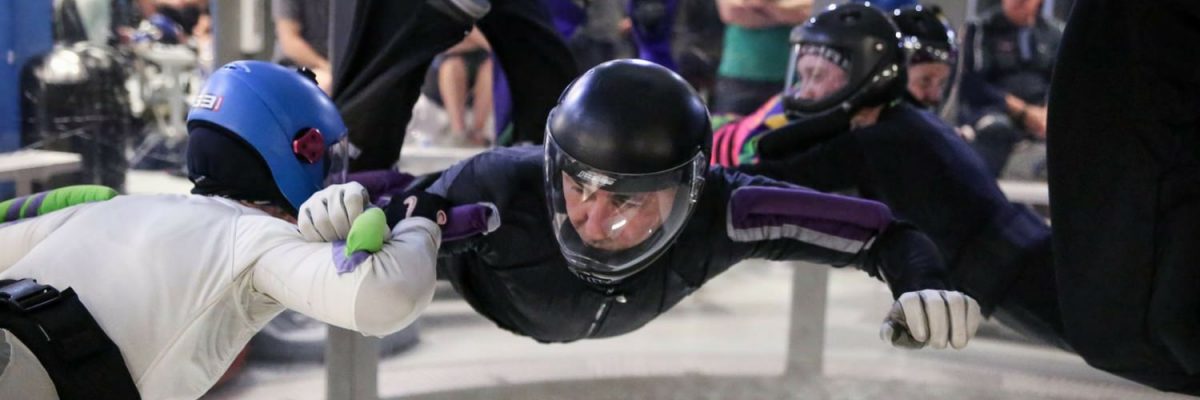
Indoor Formation Skydiving Competitions Explained
Wednesday, January 18, 2017
- Team XP
- 1/18/17
- 0
- Indoor Skydiving
It wasn’t long ago that indoor skydiving was a super-niche sport. We’ve been around since its beginnings–when it was little more than a diverting afternoon novelty when the weather outside was too bad to do much else. From those humble beginnings, the indoor skydiving wind tunnel has become a giant on the airsports scene, essentially changing the way we learn to fly. Part and parcel of that, of course, is competition–where practitioners come together to show the world the fun tricks they’ve learned.
As more and more new people learn how to fly (and spend more time perfecting their moves in the flight chamber), dedicated tunnel flyers naturally look for a next step. Competing in the indoor skydiving arena is the next logical step, giving hardcore hobbyists direction, structure and goals.
Flying in the wind tunnel is definitionally a sport. Flyers generally have a long, challenging progression that requires serious investment and steely determination. While the tunnel offers several different competitive disciplines in which to specialize–each with its own requisite skillset, rules, team numbers and scoring systems–there are similarities. Each of these disciplines, for instance, is separated into classes by experience and age. Each is extremely specific as to the skills it requires. And each is getting more and more competitive by the year.
Here, we’ll take a look at just one of these disciplines–Formation Skydiving, or “FS”–to give you a general idea of what indoor skydiving competition requires.
What Tunnel Formation Skydiving (FS) Looks Like
Formation skydiving is a speed-driven, high-intensity team discipline wherein all participants fly in the belly-to-earth configuration. FS flyers can choose to compete in 2-way, 3-way, 4-way or 5-way formations. Competitive subcategories are determined by the skill level of the team.
The competition is based on the formations that the team makes by holding on to grips located on different parts of their teammates’ bodies. Each formation has a number and a name, and each is judged on its precision. During each round, competitors are given a specific sequence of formations that they have to complete in order, as many times as possible, within a time limit of 35 seconds. Competitors complete a minimum of three rounds; after all rounds are performed, the team with the most points wins.
How Tunnel Formation Skydiving (FS) Is Judged
During the competition, the hosting tunnel is kitted out with cameras. There’s usually one facing down from the top of the tunnel and one on the level of the net, both of which are set to capture images of the entire flight chamber. Because the discipline moves so quickly, judges use the videos as well as their live observations to judge the rounds. Judges then tally scores for each round, adding them up at the end to determine the winning team.
How Tunnel Formation Skydiving (FS) Is Scored
Scoring is relatively straightforward. Each time the team successfully completes a formation within the sequence, that counts as a point. Each time the team correctly performs a block of formations within the designated time, they get two points.
Mistakes, of course, are penalized. If a team forgets a formation–or substitutes a different move for the one they were supposed to do–three points are deducted. If the move is unclear or unjudgeable (or if a teammate touches the net, or if they don’t completely break their connections between blocks), the team receives no points for the move.
This scoring keeps up until the 35-second clock runs out.
How To Get Involved
There’s a reason competitive tunnel flying has experienced such a renaissance! If you’re into flying, go for it–come on over and make your intentions known to find a team. Setting a firm competitive goal, will help you progress quicker in your flying…and, perhaps, end up with a pretty trophy.
To experience world-class competitive formation skydiving first hand, be sure to join us for our Annual Indoor Skydiving Championship. We hope to see you there!

Thanks so much for a wonderful first time adventure for me and my 5 year old great-niece; and also my 2nd timer niece. I felt very safe and informed through the whole process. My only wish is that we had ParacleteXP in Minnesota-with you to guide us! Thanks again for a wonderful time. We will DEFINITELY be back next time when in NC.
Ellen Adams
Copyright © 2024, Paraclete XP Indoor Skydiving, All Rights Reserved.
DropZone Web Design & Marketing by Beyond Marketing, LLC